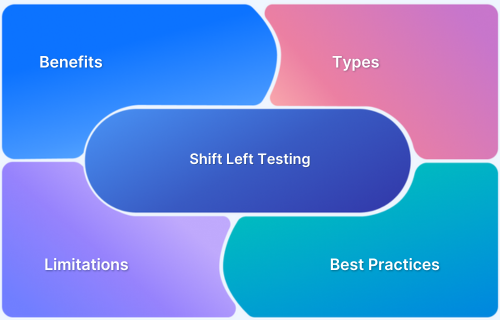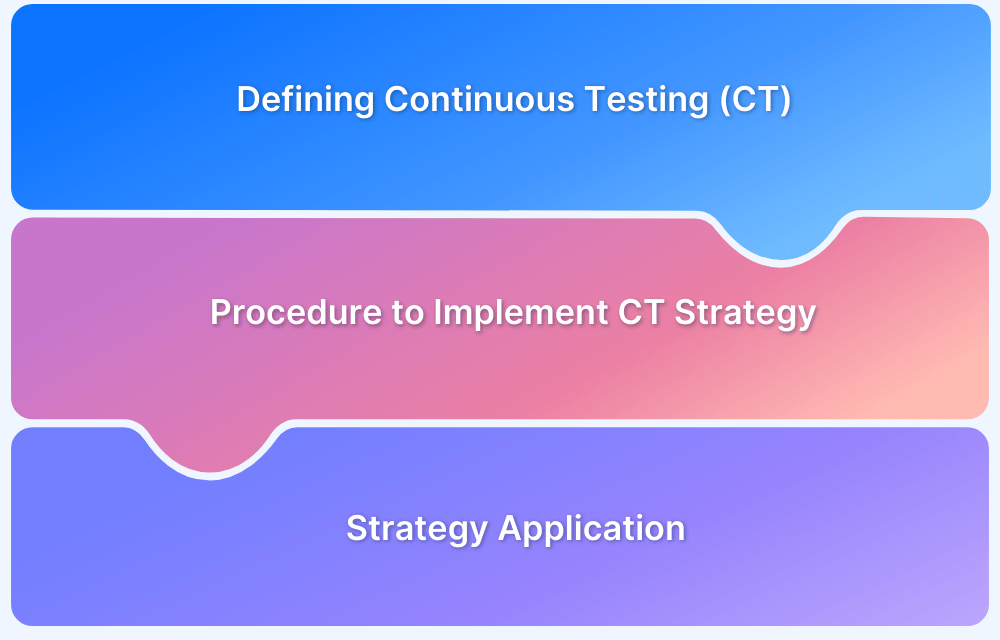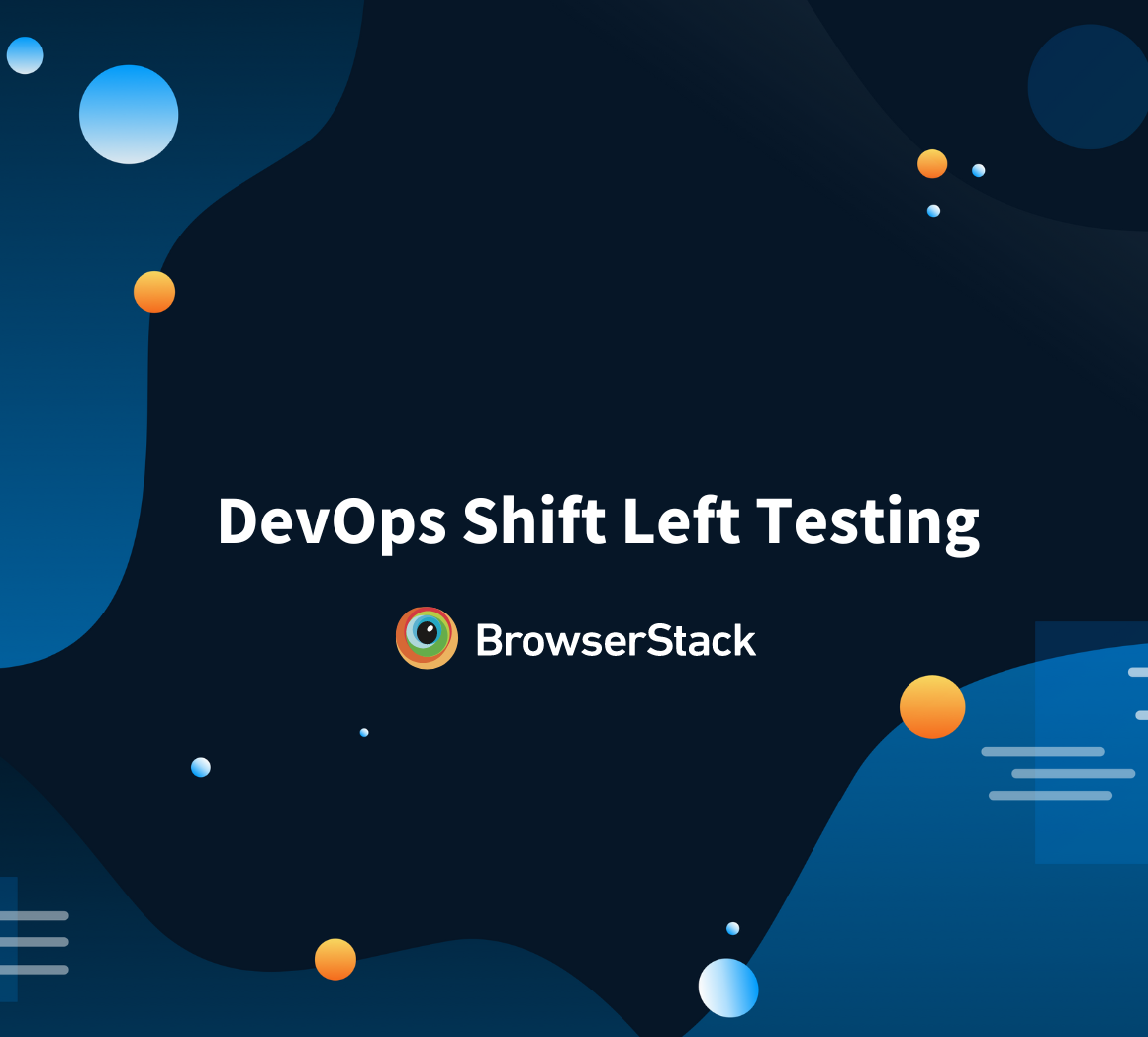With the rise of Agile methodologies like DevOps, Kanban, and Scrum, Shift Left Testing has become essential for faster releases by integrating QA early in development.
However, as user expectations for flawless functionality grow, Shift Right Testing complements Shift Left by ensuring real-world validation.
Overview
What is Shift Left Testing
A proactive approach that moves testing earlier in the development lifecycle to detect defects early, reduce costs, and improve software quality.
What is Shift Right Testing
It focuses on testing in production and post-deployment environments to ensure reliability, performance, and user satisfaction in real user conditions.
Shift Left Testing vs Shift Right Testing: Main Differences
- Focus: Shift Left focuses on early detection of defects and code quality, while Shift Right focuses on monitoring real-world performance and user behavior in production.
- Cost Efficiency: Shift Left is cost-effective as it detects issues early, whereas Shift Right can be more expensive due to post-deployment fixes.
- Types of Testing: Shift Left involves unit testing, integration testing, and static analysis, while Shift Right involves performance testing, load testing, and gathering user feedback.
- Speed of Feedback: Shift Left provides quick feedback during development, while Shift Right provides slower feedback, often after deployment based on real-world usage.
- Bugs Detected: Shift Left detects code-level bugs and integration issues, while Shift Right detects production-level issues like performance problems and user experience issues.
This article shares insights into the efficacy and applicability of shift left and shift right testing.
Shift Left Testing
In traditional SDLCs, testing begins at the very end of the pipeline. Shift Left Testing literally moves testing to the “left,” i.e., to earlier in the pipeline. QAs use shift left tests to detect and fix bugs as early as possible in the development pipeline.
This reduces the time they might otherwise have to spend fixing the same issues later in the pipeline, by which time they might have magnified and become much more difficult to isolate and eliminate without breaking some part of the software.
In practical terms, this translates to more tests being run by developers themselves before they push their individual code units to version control. There are a number of tests every developer should run to contribute to the success of Shift Left Testing and push better products.
When designing shift left tests, teams must prioritize the following:
- A thorough study of application performance, client requirements, and user expectations
- Prioritizing the creation of robust unit, integration, and functional tests
- End-to-end automation of testing funnels
- Adoption of TDD and BDD-driven tests.
For a deeper exploration of Shift Left Testing and its benefits, have a look at Shift Left Testing: What It Means and Why It Matters.
Read More: DevOps Shift Left Testing: A Detailed Guide
Shift Right Testing
Shift left involves moving tests earlier in the dev cycle, and shift right is the other extreme – moving tests to the “right”, i.e. testing, the product after it has been released to end-users. The intent is to evaluate how the application performs in real-world conditions. Through shift right tests, teams can monitor how the app and APIs perform, as well as gain insights into usability and user perception.
Shift right reveals how the software responds to unfavorable situations. Such insights and usage data are essential for teams to continue building on and improving software quality by optimizing new features or adding new ones. At a high level, this mode of testing aims to:
- Identify user preferences through A/B testing or Blue-Green deployments. They help you judge if users prefer one version over another.
- Establishing backend stability through canary tests and dark launches. In this category of tests, you release new code incrementally to check if it disrupts with normal functionality.
- Detect production issues as early as possible. For example, monitoring how much real traffic and user request load the application can actually handle, is something not easy to test in pre-production environments.
Shift right testing is quickly becoming an important component of DevOps, as it helps further bridge the gap between development, QA, and Operations teams. By setting up a continuous feedback loop, testers continue to share responsibility with devs and Ops personnel, extending the DevOps mindset into post-production management.
Read More: Different Types of Testing in Software
Types of Shift Left Testing
Here are some of the types of Shift Left Testing:
1. Traditional Shift Left Testing: Traditional Shift Left Testing focuses on moving testing earlier within the development phase.
It primarily detects defects during unit and integration testing stages, helping to identify issues before they progress further. This approach is commonly used in Waterfall and V-Model testing methodologies.
2. Incremental Shift Left Testing: Incremental Shift Left Testing is prevalent in Agile and DevOps environments. Testing is integrated into small, incremental software builds, allowing for continuous validation throughout the development cycle.
This method ensures that bugs are detected and resolved before they become complex and costly.
3. Agile/DevOps Shift Left Testing: Agile/DevOps Shift Left Testing extends testing deeper into the requirements and design phases.
It incorporates automated testing, test-driven development (TDD), and continuous integration/continuous deployment (CI/CD) pipelines to provide rapid feedback loops. This approach significantly reduces the time required to detect and fix defects.
4. Model-Based Shift Left Testing: Model Based Testing starts as soon as software architecture and design models are created.
By simulating system behavior before the actual development begins, this approach helps detect design flaws early and ensures that the software aligns with business requirements.
Types of Shift Right Testing
Here are some of the types of Shift Right Testing:
1. A/B Testing: A/B Testing involves comparing two different versions of a feature or application to determine which performs better. This testing method helps in data-driven decision-making and optimizing user experience by analyzing real user interactions.
2. Chaos Engineering: Chaos Test Engineering introduces controlled failures in a production environment to test system resilience.
By deliberately injecting faults, teams can identify weaknesses and improve system stability, ensuring that the software remains reliable under unexpected conditions.
3. Canary Releases: Canary testing involves deploying a new feature or update to a small subset of users before rolling it out to a larger audience. This method allows teams to monitor performance and detect issues in a controlled manner, reducing the risk of widespread failures.
4. Feature Flag Testing: Feature Flag Testing enables or disables specific features dynamically in a production environment without requiring a new deployment. This approach allows teams to perform safe experimentation, conduct gradual rollouts, and quickly roll back features if issues arise.
5. Real User Monitoring (RUM): Real User Monitoring collects real-time data on how users interact with an application.
This approach helps teams track performance issues, user behavior, and potential bottlenecks, enabling continuous optimization of the software.
6. Synthetic Monitoring:Synthetic Monitoring simulates user interactions in a production environment to proactively detect performance issues. Continuously running automated tests ensures application availability and reliability before real users experience any problems.
Benefits of Shift Left Testing
Shift Left Testing is a proactive approach that integrates testing early in the software development lifecycle (SDLC). By shifting testing to the left, organizations can detect and resolve issues before they escalate and ensure a more efficient development process.
Below are the key benefits of Shift Left Testing:
- Early Bug Detection and Fixing: Shift Left Testing helps identify and resolve defects in the initial phases of development, reducing the cost and effort required for later-stage bug fixes.
- Improved Software Quality: By incorporating continuous testing from the beginning, Shift Left Testing ensures a higher-quality product with fewer defects and better stability.
- Faster Time to Market: Detecting issues early in the development lifecycle reduces delays caused by late-stage defect identification, leading to quicker product releases.
- Reduced Development Costs: Fixing defects early is significantly cheaper than addressing them after deployment, minimizing rework and lowering overall development expenses.
- Enhanced Collaboration Between Teams: Developers, testers, and business analysts work closely from the beginning, fostering better communication and reducing misunderstandings regarding requirements.
- Better Requirement Validation: Continuous testing ensures that software requirements are validated early, preventing scope creep and misaligned expectations.
- Increased Test Coverage: Automated testing and early validation improve test coverage, ensuring that all critical functionalities are thoroughly tested.
- Stronger Security Posture: Security vulnerabilities are identified early in development, reducing the risk of costly security breaches post-release.
- Efficient Resource Utilization: Developers spend less time debugging late-stage issues, allowing them to focus on feature development and innovation.
- Support for Agile and DevOps Practices: Shift Left Testing aligns with Agile and DevOps methodologies, enabling continuous integration, continuous testing, and continuous delivery (CI/CD).
Benefits of Shift Right Testing
Shift Right Testing focuses on testing in production and post-deployment environments. It allows teams to evaluate real-world performance, user behavior, and system resilience. Organizations can enhance software reliability, optimize user experience, and ensure continuous improvement by shifting testing to the right.
Below are the key benefits of Shift Right Testing:
- Scope for expanding automation: Intelligently implemented automation is at the core of good DevOps. Tests within the shift right principle, such as feature flags, canary tests, and dark launches, provide excellent scope for automation. They help automate feature releases, keep teams updated on software performance and promote optimal use of time and effort.
- Helps roll out better user experiences: Shift right tests do more than just collect customer feedback. They translate such feedback into improvements, which benefits the software technically and boosts its business value. Quite simply, it helps teams quickly fix what users want them to fix.
- Expands test coverage: When you start shift right tests, you expand test coverage beyond software release. By continuing tests in production, you increase the chances of identifying and resolving bugs that would otherwise contribute to an undesirable user experience.
- Fact-based learnings for future projects: By monitoring user experience and real-world software behavior, teams can get invaluable data on what users within certain demographics tend to like, not like, and be indifferent to. In future development projects handling software of similar nature, these data points can help with creating specific development and test design documents.
It also helps ascribe time and effort to features and capabilities that really matter. For example, if previous shift right tests for an e-Commerce have shown that users in a country don’t care about using in-app social media integrations, devs can deprioritize the feature and focus on creating software abilities higher on users’ priority lists.
Shift Left Testing Tools
Some of the widely used Shift Left Testing tools include:
- BrowserStack: A cloud-based cross browser testing platform that enables developers to test web and mobile applications on real devices and browsers. It ensures cross browser compatibility and early bug detection.
- Selenium: A powerful automation tool for web applications that enables early functional and regression testing.
- JUnit: A widely used unit testing framework for Java that enables developers to test code at the component level.
- TestNG: A testing framework for Java that supports parallel execution, data-driven testing, and better reporting.
- Cypress: A modern JavaScript-based end-to-end testing framework for web applications with real-time debugging features.
- Jest: A JavaScript testing framework primarily used for unit and integration testing in React and Node.js applications.
- PyTest: A Python testing framework that supports unit and functional testing with easy-to-read test cases.
- SonarQube: A code quality and security analysis tool that detects vulnerabilities and maintains code standards from the early development stages.
- Checkmarx: A static application security testing (SAST) tool that helps detect vulnerabilities in the early coding phase.
- Jenkins: A CI/CD automation server that integrates testing into continuous integration pipelines for early defect detection.
Shift Right Testing Tools
Shift Right Testing focuses on validating software in real user conditions, ensuring performance, security, and user experience. The following Shift Right tools help in production testing, monitoring, and chaos engineering:
- AppDynamics: It is an application performance monitoring (APM) tool that provides real-time visibility into application performance, helping detect bottlenecks and optimize response times.
- Dynatrace: It is an AI-driven APM tool that offers deep observability, automatic root cause analysis, and performance monitoring for cloud and on-premises applications.
- New Relic: A full-stack observability platform that monitors application performance, infrastructure, logs, and user experience in real time.
- Splunk: A log analysis tool that collects and analyzes machine data, helping teams troubleshoot errors and improve system reliability.
- Graylog: A centralized log management tool that allows organizations to monitor and analyze system logs to detect security threats and operational issues.
- ELK Stack (Elasticsearch, Logstash, Kibana): A powerful open-source log analysis and visualization suite that enables real-time data monitoring and analytics.
- Mixpanel: A user analytics tool that tracks user interactions and behaviors to provide actionable insights for improving engagement and retention.
- Google Analytics: A widely used analytics tool that helps measure user behavior, traffic patterns, and application performance in production environments.
- Amplitude: A product analytics platform that helps teams understand user behavior and optimize digital experiences based on data-driven insights.
- UserVoice: A feedback collection tool that enables businesses to gather and analyze user feedback to prioritize feature enhancements and resolve customer concerns.
Shift Left vs. Shift Right Testing: Which to choose?
Shift Left and Shift Right testing complement each other rather than replace one another.
Shift Left focuses on early, automated testing to catch bugs and risks during the development phase, ensuring software quality before issues become deeply integrated.
Shift Right monitors real-world user behavior, performance, and security in production to identify bugs and optimization opportunities missed earlier.
While Shift Left aims to catch issues early, it’s impossible to predict every real-world scenario. Shift Right allows teams to address user feedback and fix issues that affect user experience, bridging the gap between testers and operations teams.
Combining both approaches supports DevOps best practices, enhancing the software lifecycle from development to post-production optimization.
| Aspect | Shift Left Testing | Shift Right Testing |
|---|---|---|
| Timing | Testing is done early, during the development phase. | Testing occurs later, post-deployment, and in production. |
| Focus | Focuses on preventing defects and ensuring code quality early. | Focuses on real-world performance and user behavior in production. |
| Cost Efficiency | Helps reduce costs by identifying issues early in development. | Can be more expensive due to issues being discovered later in the cycle. |
| Types of Testing | Includes unit testing, integration testing, and static analysis. | Involves performance testing, monitoring, and user feedback. |
| Tool Usage | Primarily uses CI/CD tools, static code analysis, and unit testing frameworks. | Uses monitoring tools, performance testing tools, and log analysis. |
| Bugs Detected | Identifies code-level bugs and integration issues. | Identifies production-related issues like load problems and user experience. |
| Speed of Feedback | Provides quick feedback to developers during the coding phase. | Feedback comes slower, usually after the product is live. |
| Risk Mitigation | Reduces risks by catching bugs early in the development cycle. | Reduces risks by monitoring real-world user experiences and system performance. |
| Environment | Testing is done in a controlled, pre-production environment. | Testing is done in a live, production environment. |
| Goal | Ensure quality early and prevent defects from reaching users. | Ensure the application performs well in actual usage conditions. |
Role of Real Browsers and Devices
Whether they use iOS, Android, Mac, Windows, Google Pixel, Oppo or other popular devices, software functioning on the same device can be verified from the comfort of your home, thanks to our remote testing options.
Uncompromising security & privacy. BrowserStack is SOC2 Type 2 and GDPR compliant. It also ensures pristine devices for each test. All browsing data is completely destroyed with every logout.
Conclusion
Shift Left and Shift Right Testing together ensures high-quality software by catching defects early and validating real-world performance.
Shift Left focuses on early testing, automation, and cost reduction, while Shift Right enhances reliability through monitoring, user feedback, and production testing. You should have a balance in both approaches for the ideal outcomes.
For teams looking to enhance Shift Left Testing, BrowserStack provides a powerful platform to test applications on real devices and browsers. This ensures cross-platform compatibility, early bug detection, and faster releases, helping developers deliver flawless applications from the start.







